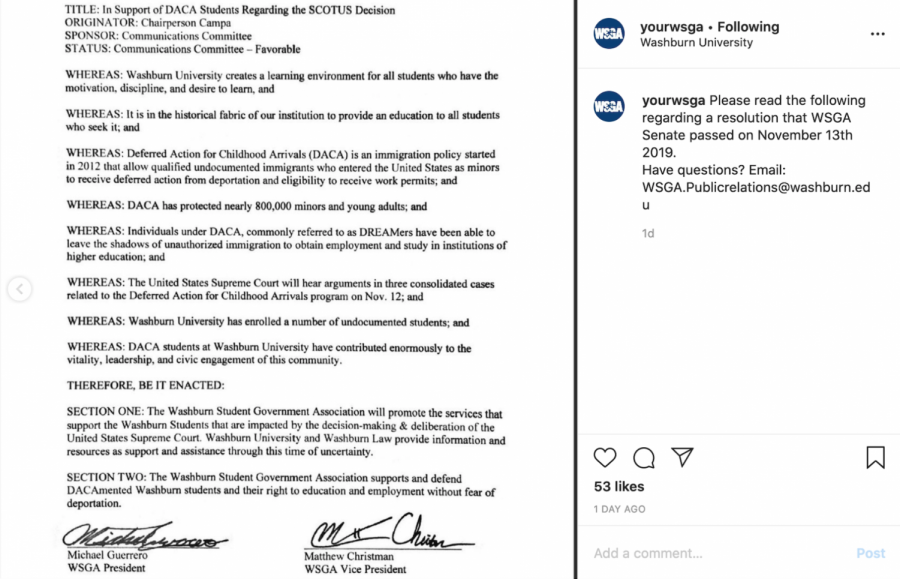WSGA passes DACA support resolution
November 18, 2019
The Washburn Student Government Association senate passed a resolution Wednesday, Nov. 13 that will help to protect Deferred Action for Childhood Arrivals, or DACA, students on Washburn University’s campus.
The resolution has two enacted sections. Section one states WSGA will promote services that support Washburn students that are impacted by decisions made by the United States Supreme Court. Section two states WSGA will support and defend DACAmented Washburn students and their right to education and employment without fear of deportation.
WSGA Communications Chairperson Mayela Campa, the originator of the DACA resolution, believes that the first step to making change is raising awareness around the complexity of the United States Supreme Court decision regarding DACA.
The United States Supreme Court is currently holding hearings over the possibility of abolishing the program. The Supreme Court is expected to rule by the end of June 2020.
“I wish it [the topic of DACA] wasn’t so political and that was my biggest problem when we were having our discussion in the Senate,” said Campa. “I am here trying to support students… it doesn’t have anything to do with a political agenda. It’s preventing people from being separated from their loved ones.”
According to the Immigrant Legal Resource Center, DACA is an immigration policy originally instituted and established by the Obama administration in 2012. The policy allows qualified undocumented immigrants who entered the United States as minors to receive deferred action from deportation. These undocumented immigrants are eligible to receive work permits and attend higher education institutions.
As of June of 2019, the Migration Policy Institute estimates that over 1.3 million individuals in the United States are immediately eligible for DACA based on the program’s criteria outlined by the Obama administration in 2012.
In June of 2019, Kansas was home to 5,750 DACA recipients and MPI estimated about 8,000 Kansans were eligible to receive DACA benefits, according to data from U.S. Citizenship and Immigration Services (USCIS).
Individuals can file and renew their DACA status for 2 years. DACA doesn’t provide a path to U.S. citizenship but rather gives individuals temporary protection from deportation. Many individuals are renewing in fear that the program could end.
“Both of my parents are Mexican immigrants and I’ve always wanted to practice immigration law. The main purpose was to create awareness on Washburn’s campus for the decision that the Supreme Court is going to decide over the DACA program,” said Campa.
According to the official Washburn University webpage, “Washburn creates a learning environment for all students who have the motivation, discipline and desire to learn. We hope the legal issues surrounding DACA students will be resolved quickly to minimize the anxiety and stress for those adversely affected.”
The university is currently working toward building a student resource center on campus for underrepresented groups.
Washburn University Vice President of Student Life Eric Grospitch stated in an email Monday that construction for that project will begin on the main level of the Memorial Union over winter break. Grospitch added that the Office of Student Involvement [OSID] will be moved upstairs, across from the corner store, making the current OSID office space open for a resource center.
“The need for a resource center came from a request from underrepresented groups so that will be the driving force – but all will be welcomed,” said Grospitch. “It’s still in discussion as to the full functionality of the center, but it’s intended to be a place where students can study and relax.”
WSGA Chief of Staff Caleb Soliday had his own interpretation of what the new resource center will mean for underrepresented groups at Washburn.
“It’s more symbolic of showing support for students and acknowledging that those students exist on campus. That creates a discussion for the student body,” said Soliday.
Edited by Adam White, Jackson Woods, Abbie Barth



